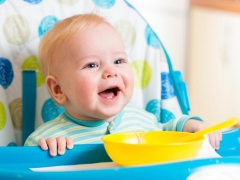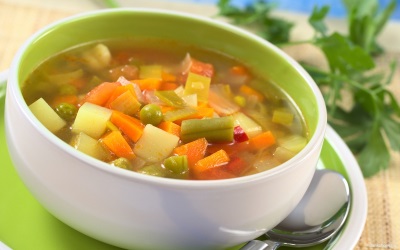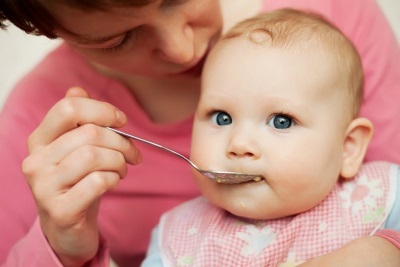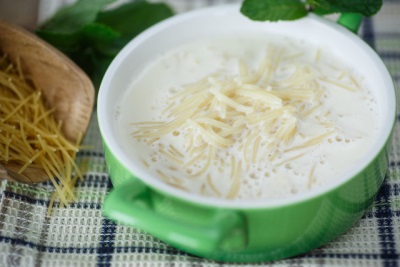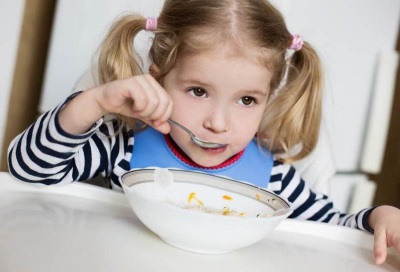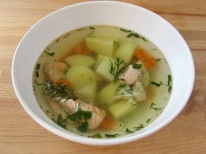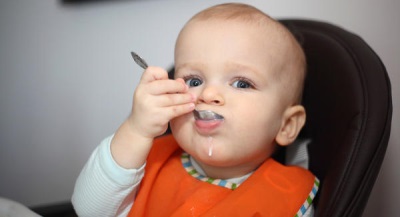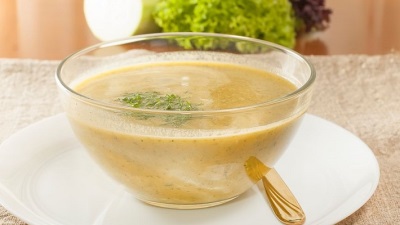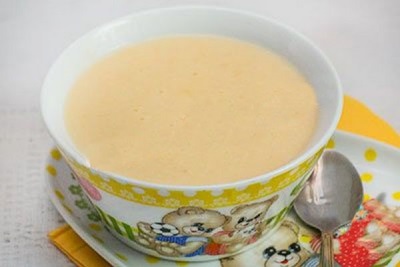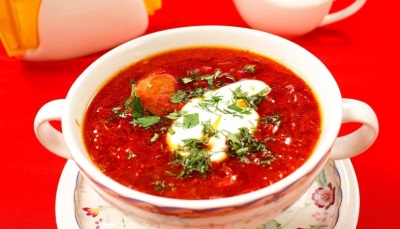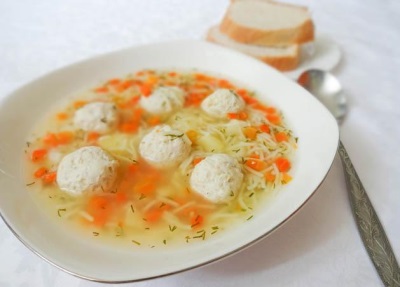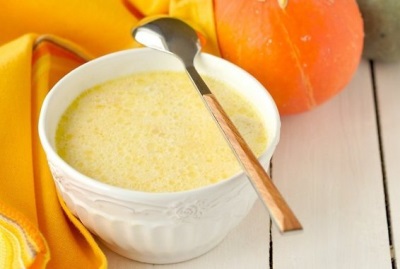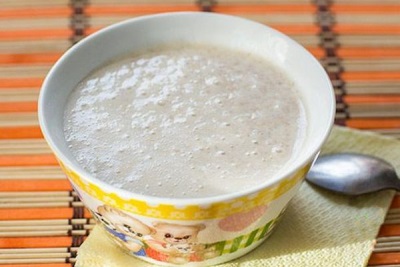At what age can you give soup to a child and what recipes are suitable for a one-year-old baby?
Until six months, the baby does not need any additional food other than breast milk, but when the crumbs turn 6 months old, doctors recommend starting to feed the baby with vegetable puree or cereals. Next, the dishes on the table baby are becoming more diverse. Soups appear among them. But, so that they can be assimilated without problems and bring only benefit to the body of the children, it is important to know which ones are allowed in the diet of children under one year old and when it is possible to cook them in broth.
How old can you cook?
On average babies are ready to try soups at the age of 9 months or 10 months, however, one should focus on the individual development of the crumbs. Some babies can be given such meals at 8 months, and someone refuses them for up to a year.
If the child is mixed or formula-fed, the soup in his menu may appear a little earlier - from 6-7 months. It is offered to children younger than a year. at lunchtime up to 150 ml. After a year the portion increases to 200-250 ml.
Benefit
- Restores water supplies, and also acts as a source of various nutrients, among which there are easily digestible proteins, minerals, fiber and vitamins.
- Stimulates digestion, in particular, such a dish activates the secretion of digestive juices, which is why it is called “first”.
- These first courses are mainly diet meals that can be consumed with overweight.
What are the?
Depending on the basis and components in the children's menu there are such types of soups:
- Vegetable This is the first soup for a child up to a year, which is cooked exclusively from vegetables. For very young people, it is cooked in the form of a puree soup, grinding all the ingredients until a homogeneous semi-liquid mass is obtained. For children from 1 year old, vegetables are boiled in pieces so that the baby learns to chew. Vegetable first courses from pumpkin, from broccoli, and also from cauliflower are especially popular.
- Dairy. Their ingredients are boiled, for example, vermicelli or grits, poured boiling milk (before the age of two, milk is twice diluted with water). This soup is rich in proteins, starch and vitamins, it is quite nourishing and is liked by many children.
- Cereal or pasta. This dish is quite satisfying and gives the child a lot of carbohydrates, vegetable proteins and vitamins of group B. For kids, rice or buckwheat soup is most often cooked, adding vegetables to such cereals.
- From legumes. For children younger than a year, you can make a green pea cream soup or from a pod. beans. Also, young beans and peas can be added in small quantities in vegetable first courses. Dry pea soup appears in the diet of children from 3 years.
- Cheese. Such a dish can be prepared on water, vegetable or chicken broth. Its ingredients are quite often vegetables and boiled chicken, but the main "highlight" is cheese.A small amount of grated hard cheese is added to it at the end of the brew and wait for the cheese to melt. This gives the dish a special taste and delicate texture. Cheese first courses are recommended to be prepared for children older than a year, but processed cheese should not be added to them until 3 years of age.
- With meat. Pureed boiled meat is added to children's vegetable soups from the moment of introduction of meat lures. Children over 10 months old can add a little broth to vegetable soups, and cook them for meat broth advised from the age of one. Meat in them for a child of 2 years may already be small pieces. Such dishes are often cooked from rabbit or beef. Also for children over 1.5 years old soups with meatballs are popular.
- Chicken. For kids younger than a year, this dish is prepared with the addition of low-fat chicken meat, after which everything is ground to obtain puree. Kids older than a year begin to cook soup in chicken broth, for which low-fat chicken is used. From the age of 1.5, babies are starting to offer first courses with chicken meatballs, and from the age of 3 they can be cooked on whole chicken. No less tasty they are obtained from turkey.
- Fish. This version of the first dish is introduced into the children's diet from 1 year. First, for him use river fish, carefully cleaned of stones. It is boiled separately, and then added to the soup with vegetables or cereals at the end of cooking to make a cream soup. A little later, the child can be treated to soup with fish meatballs cooked separately, and also begin to cook the soup in a loose fish broth.
- Fungal. They are quite difficult to digest, therefore they are not recommended for children of preschool age. Also to soups, which are not worth trying at an early age, include pickle, hodgepodge and kharcho. Include them in the children's diet should not be earlier than 3 years.
How to cook
To make the soup useful for the child, it is important to consider the following principles when preparing it:
- Cook them for kids only from those products that the child has already tried. If you want to add a new ingredient that has not yet been introduced to complementary foods, it should be the only new component of the dish, presented in very small quantities, for example, 1 spoon of broth.
- Use for cooking special purified water intended for children (bottled). For young children, do not cook the soup in tap water, even if it is boiled.
- When choosing vegetables, make sure they are fresh. It is unacceptable to use damaged, overripe or rotten vegetables to feed children. Before cooking, all vegetables should be thoroughly washed, then peel off and cut into not too small pieces (if crushed, nutrients are destroyed faster). Fry vegetables in the cooking process should not be up to 3 years of age.
- If you are going to cook baby soup with meat, this product should be with a minimum of fat. When cooking broth, it is recommended to use the second or third water (drain the first water after boiling and pour the meat with clean water).
- Children should be fed only fresh soup, so do not cook too large portions. Do not give a small child a dish that has been stored in the refrigerator for more than a day.
- To preserve valuable compounds in products, do not boil them for too long. A strong fire is permissible only to bring water or broth to a boil, after which the heating should be minimal.
- Until the age of three, strong meat, fish or chicken broth is advised to be avoided. Also for children's first dishes should not use bouillon cubes.
- In the finished dish, you can add a little vegetable or butter, yolk. From the year soup for a child can be sprinkled with chopped herbs.
- If the child does not refuse unsalted soup, it is not necessary to add salt. The less salt will be in dishes for children younger than 3 years, the better.However, with the child’s categorical reluctance to eat unleavened soup, a small amount of salt is permissible.
Recipes
From the zucchini
Take 100 grams of vegetable, wash thoroughly, removing seeds and peel, and then cut into small pieces. Boil zucchini until cooked and hot through a sieve or chop with a blender. Dilute the puree with broth and bring to a boil, and then add a piece of butter or mashed quail egg yolk to the soup.
From rabbit
Rinse and then slice 100 g of rabbit meat, then boil until cooked. Next, peel and chop the potatoes and any vegetables to taste (cauliflower, zucchini, Brussels sprouts, green beans, carrots and others in the total about handful). Boil the vegetables in water until soft, add boiled rabbit meat and chop the blender to a semi-liquid puree.
From fruit
Take one apple, one peach and 3 apricots, peel the fruit and remove the seeds. Cook them in a small amount of water until soft, then wipe with a sieve. After adding a teaspoon of semolina to the fruit puree, boil for 3 minutes, then add the pounded yolk and 100 ml of milk into the soup, stirring the dish continuously. When it boils, immediately remove the dish from the heat. You can give it to a child both warm and chilled.
For children older than one year
Borscht
Such a dish in the children's version can be cooked only from vegetables, with the addition of boiled meat or in meat broth. To cook borscht can be both on the stove and in the multicooker. Take for a dish of beets, carrots, onions, tomatoes, a few potatoes and 100 g of chopped cabbage. After washing all the vegetables, peeling and grinding them, lay them in boiling water, taking into account the duration of their heat treatment.
First boil the potatoes and onions, then grated carrots and beets, and at the end add cabbage and sliced tomato without skin. Add salt and herbs to your dish. If the child is already 2 years old, borschik can be refilled with low-fat sour cream.
With noodles and chicken meatballs
For this nutritious soup, take an onion, carrot and 2 potatoes. Cut vegetables and boil in a little salted water for 10-20 minutes. Next, add in a boiling dish of meatballs of minced chicken, mixed with egg and salt. After 5 minutes add vermicelli to the dish. Cook until all ingredients are ready, and sprinkle with chopped greens before serving.
Pumpkin with semolina
Peel and grate the pumpkin, and then boil it until half cooked. Add to the soup half a glass of milk and a teaspoon of semolina. Boil the ingredients until tender, remove from heat and pass through a sieve. Dilute all with boiled water, add a teaspoon of sugar and boil the dish for about 3 minutes. Finish the finished dish with butter.
Milk with oatmeal
Pour 20 g of flakes in 150 ml of water and boil for a few minutes. Next, add 200 ml of boiled milk and cook the soup for about 20 minutes. At the final stage of cooking, add sugar and salt to taste, as well as a little butter.
The recipe of onion soup with cream and turkey ham, see the transfer of Dr. Komarovsky.
